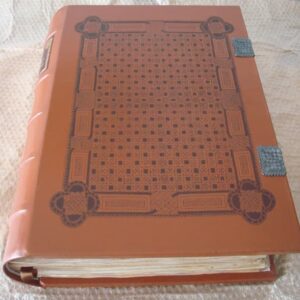Description
Beatus of Ferdinand I and Doña Sancha, also called Beatus of Facundo (Facundus scripsit) by the name of its author, is conserved in the BNE with the signature Beato de Liébana, In Apocalipsin, Codex of Fernando I and Doña Sancha, Ms. Vitr. 14-2. This manuscript was written in the middle of the eleventh century, according to the text of folio 316: It was bis quadragies et V post millesima; that is, in 1047. The artist was careful to number the notebooks in the turns of the last folio. Thus, we see the number I in Roman in folios 25v, the II in 33v, and so correlatively, since the notebooks are perfectly regular with 4 diptychs or eight leaves. This means that two ternions (12 folios) containing the Preliminaries were added in front, at another time and by another hand, although very close in time.
The colophon (f. 316) contains the name of the copyist: Facundus scripsit, who would also be the painter. No name of abbot or monastery appears, although the work could be done in a highly specialized scriptorium; possibly Sahagun. The coincidence of the name of the copyist (formerly Arab) and that of this monastery (Santos Facundo and Primitivo), gives rise to debate. The authors who maintain that the codex was composed in San Isidoro de León, may have taken into account that the Basilica was inaugurated in 1063, after being built in the place of the Church of San Juan and San Pelayo; therefore, the dating written by the author would be questioned. However, the Labyrinth (f. 7r) dedicated to Fernando and Sancha, whose names appear in all directions in the 840 square that form it, contains a frame with six portraits, which has led certain authors to affirm that this manuscript takes Central European artistic trends, especially from Reicheneau. Others, however, place it within the group of Magic, which is clearly influenced, and the Mozarabic Bible of Leon (Williams). In our opinion, Blessed Fernando I and Doña Sancha is the last of the Visigothic Mozarabic Blessed regardless of the first notebook.
The Facundo Codex contains at the beginning two Genealogical Tables. The first (f. 1r-5v) do not correspond. They were bound in the last restoration, so they were numbered as their own; but supposedly they belong to Blessed Valcavado, which he lacks. Both codices were together in the Basilica of San Isidoro when they were discovered in 1572 by Ambrose of Morales, chronicler of Philip II. The images above represent the letter Alpha, which only contains four Romanesque Blessed, but no Visigothic; except that of Fernando I. The second of the Seven Churches, on the other hand, is only missing in four of the 21 Blessed Miniatures.
This Blessed National Library stands out for its color that is not seen in any other, and for the perfection of the compositions that, according to Williams, make it “the most elegant of the Blessed.”
The Beast, which is the dragon and the devil, is one of the main pictorial elements of the Blessed. The Woman on the Beast (usually represented twice) and the Adoration of the Beast, are the most attractive illustrations for the altomedieval monks, judging by the number of times they are represented; either for the spiritual, sinful or eschatological meaning. Twelve are the Blessed that contain this miniature, and there are also twelve that contain Daniel’s cycle, although only half is complete. Blessed of Facundo has 9 miniatures of the twelve possible; but not because he lost them, but because the artist did not compose them. In the miniature on the right, again and for the last time the Beast is represented in different historical ages: Chaldeans, Medes, Persians and Macedonians.
Facsimile format: 27 x 36 cm. 624 pages, 114 thumbnails. Binding in steely skin. Edition numbered and limited to 777 notarized copies. It is delivered in a wooden case lined with steely leather, similar to the codex.
Study book format: 28 x 38 cm. Pages: 312. Illustrations: 138. Content: From editor to reader. Foreword by John Williams. Blessed of Liebana and his world, by Joaquín González Echegaray (Director of the Prehistoric Research Institute). The tradition of the Blessed and the Blessed of Fernando I and Sancha, by Manuel Sánchez Mariana (Director of the Historical Library, Universidad Complutense de Madrid). The illustration of Blessed Fernando I and Sancha and Las miniatures, by Joaquín Yarza Luaces (Autonomous University of Barcelona). Thumbnail Index Index.
Shipping by the buyer, upon request and destination. Ask us any questions and any other Beato or fax you are looking for.
There is another cheaper facsimile edition of this Blessed by the Versol publishing house, and considered by many to be the best of the two, also available on this website.











